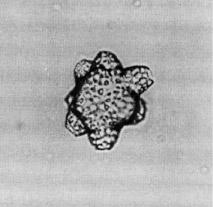 Solenosphaera
omnitubus omnitubus Riedel and Sanfilippo
Solenosphaera
omnitubus omnitubus Riedel and Sanfilippo Solenosphaera
omnitubus omnitubus Riedel and Sanfilippo
Solenosphaera
omnitubus omnitubus Riedel and SanfilippoSolenosphaera omnitubus Riedel and Sanfilippo, 1971, p.1586, pl.1A, fig.24; pl.4, figs.1-2 (non pl.1A, fig.23); Sanfilippo and Riedel, 1974, p.1024, pl.1, figs.1-5
Shell small, approximately spherical, with 4 to 8 short, truncate, cylindrical tubes without differentiated termination, which occupy most of the surface of the sphere. Pores small, subcircular, not very variable in size, similar on the tubes and the sphere (Riedel and Sanfilippo, 1971).
Based on 30 specimens. Overall diameter (including tubes) 70-120 µm. Length of tubules usually 5-10 µm, but some may be 20-70 µm (Riedel and Sanfilippo, 1971).
Riedel and Sanfilippo (1978a) treated this subspecies and S. omnitubus procera together under the specific name and characterized them as having "Short or long tubes, closely spaced, occupying almost the entire spherical shell."
According to Riedel and Sanfilippo (1971), S. omnitubus omnitubus "differs from other members of the genus in the small number of tubes which occupy a very large proportion of the surface of the sphere."
According to Sanfilippo and Riedel (1974), the nominate subspecies includes only specimens "in which the tubular prolongations are as short as, or shorter than, those in the forms" illustrated by them in 1971 excluding fig.23.
Above and below the range of S. omnitubus, and co-occurring with it, is a collosphaerid that is very similar, but has a discernible spherical center from which tubes project. S. omnitubus must be comprised entirely of tubes.
The spherical shell surface is occupied entirely by cylindrical tubes, with a minimal amount of connecting lattice. Most specimens have 4-8, rarely 10 short tubes (5-20 µm), and some have 3-6 longer tubes (20-70 µm). Pores are small (<5 µm), subcircular, irregularly arranged (Sanfilippo et al., 1985).
S. omnitubus omnitubus is found in latest Miocene to early Pliocene sediments in latitudes lower than 20° in the Indian and Pacific Oceans. Its morphotypic first appearance lies within the Didymocyrtis penultima Zone and its morphotypic last appearance lies within the Spongaster pentas Zone. In the Indian Ocean, where members of the Spongaster berminghami -> Spongaster pentas lineage are rare, the last morphotypic appearance of Solenosphaera omnitubus omnitubus can be used as a convenient approximation for the base of the Spongaster pentas Zone.
Near both ends of its range, the tubes of S. omnitubus narrow distally.